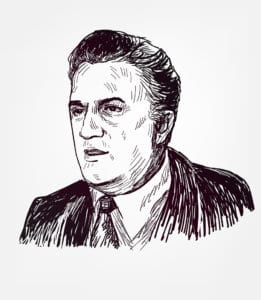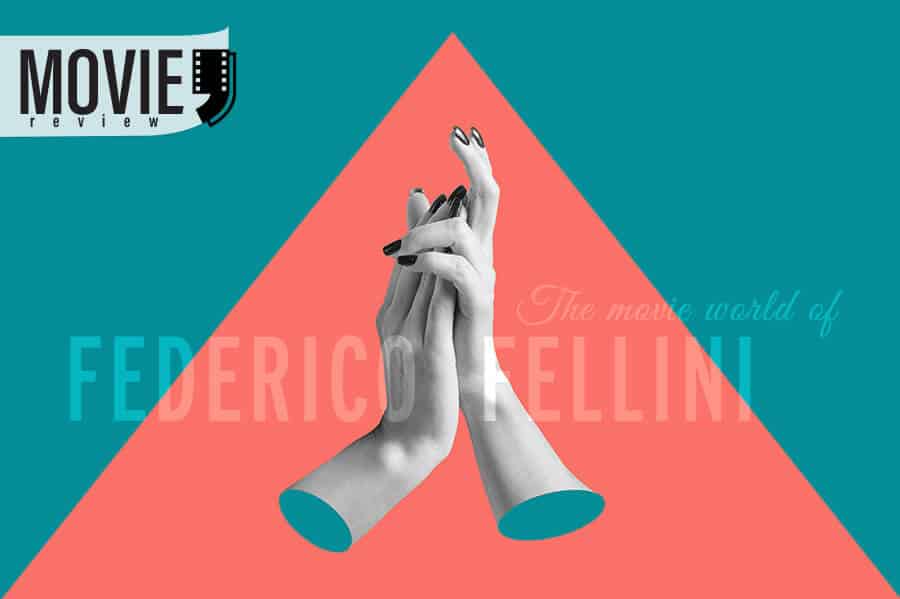Federico Fellini - legendary director. He is one of the revolutionary creators as well as Bergman, Kusturica, and more modern Sorrentino. But if Fellini was the first to declare freedom in cinema, then the last three directors inspired by him. Either way, ordinary residents of Italy became the main characters, and clowns, prostitutes and the secular society in one layer of the population to speak about life tragedy.
Writing about Fellini as a director who made a new film is complicated and inconvenient. He broadcast the thinking, fantasies, deep inner feelings. Federico Fellini is an Italian director who managed to receive all the accolades from critics for the film `La Dolce Vita`, who launched the autobiographical film genre. In his career, there are more than a dozen films, but only two are so famous that the name of Federico is associated with them only – `La Dolce Vita` and `8 ½`. For a few more centuries both are now included in the hundred best films of the last time.

Fellini’s traditions are not to give up to yourself, which means to continue to show life and its heroes from the perspectives of ordinary people: prostitutes, millionaires, secular society, directors, actors, writers. Cinema is about life with a plot of another world, because if you remember ` 8 ½ `there is science fiction, and time travel throughout the memories of childhood. The most significant protest theme is religion. After La Dolce Vita released, the church accepted the film negatively, claimed of the mass humiliating. Federico was not afraid to talk about what drives the churches and the priests, showed the distorted power of the church with a sneer recalling that everything comes from simple animal instincts. Pretend the society is a marble staircase, ones who sit a step below wipes the road for those who are above. Therefore, both the church and the femme fatale find themselves on the same path, as high as low and vicious. Even though there is life in Fellini’s films, their main feature is the metaphor, which doesn’t allow to take the plot real, without transferring the image of each character to the existing world.
Fellini: from neorealism to own parodies
There are four stages to divide Fellini career. He was one of the founders of Italian neorealism. As one of the authors of key scenes for the films, war drama Rome, Open City and Paisà. In the 50s, when Italian cinema has been rebuilt, as the whole world of cinematography. It was only for Italy that cinema became an opportunity to express the traumatic emotions that had accumulated over decades.
From political rigid frameworks to church canonical, almost totalitarian rule. Fellini became the first in the frameless style because he did not obey the classic life story for a day. And on the professional side, he also rejected to obey the classical method of cinematography. He had a draft of the script and an idea of the film. What did he want after editing? On the set, Fellini improvised because he wanted to preserve and transfer the chaos of life to the big screen. Neorealism became the key, with what Federico found the necessary lock and directed overwhelming films. Shades of neorealism were visible in the early works of The Road and the Nights of Cabiria. There Federico approved non-professional actors and ordinary people in the lead roles. His films began to acquire depth and imagery, with a parable about life.
The most important period when the whole world was talking about Fellini was in the 60s. Then he directed La Dolce Vita and 8 ½. He managed to fully reveal his handwriting as Fellini style we are used to seeing until now. Surrealism in denying the system of plot and storyline, carnival and clowns – this is how the director retail Bohemian Italy. He carefully tries to blur the line between real and unreal. In the late 60s, Federico adds the Barocco style. When colour television appeared, then his films began to be perceived differently. `Rome`, `Amarcord` are worthy attempts by the director to show the absurd and burlesque of life. He did not use colour as decoration or attribute to reinforce the plot. On the contrary, the brightness of the frame made it possible to increase the distortion of common themes that seem normal and fatal at the same time. And the most important thing was the parody itself, as the fourth stage of his career. This is an irony to himself for the aesthetics that the director has been broadcasting all the pastime. A kind of conscious rethinking that important moments could also become comical even for Federico Fellini.
Fellini’s surreal world at 8 ½ and La Dolce Vita
Fellini sought to erase the boundaries. He managed to blur the patterns between reality and fantasy. Everything that happens onscreen grew up from reality to dreams, from fantasies to reflections, from memories to real dialogues. Federico not only built a new style of shooting but also drew inspiration for future episodes. He seemed to be drifting his ideas. With the help of symbols and images, Federico freed himself from social shackles. Although the opening shots of 8 ½ speak directly: `Leave me alone, I feel bad and the reality chokes me`. This is not the only scene in these films that Fellini associates with the pursuit of freedom. In other things, in the images that conveyed the plot, Federico was not famous for character diversity. If only because Marcello Mastroianni was his most preferred actor for the main roles, and seems to have also played the role of the director’s alter ego. Both in La Dolce Vita and 8 ½, Marcello plays a member of the creative professions – a journalist and a director, prospectively. It concerns the Bohemian life, the elite of the rich, heirs of statuses, actors and actresses. The hero of Mastroianni is a man of the eternal crisis on a personal path. A crisis in creativity and personality, wandering external search unite fundamentally La Dolce Vita and 8 ½. Otherwise, 8 ½ is life opus.
Life final, until we remember, regret dream and strive to get a breath of freedom, at least once again. We conclude that life is running in a circle, with clown and funny music. Fellini always chose the roles of the marginalized characters: vagabonds, swindlers, loafers, prostitutes. Set a unique place for clowns. One got the impression that he was both afraid of them and admired. Saragina, a woman of magnificent shape, with the archetype of mother, guardianship and femininity, was frequently repeated character. Fellini was attracted to people with non-standard appearance: dwarfs, androgens, people with congenital defects, unique and eccentric. He preferred to introduce a natural character into the existing world, rather than forcing an ordinary actor to create the same world through the artificial game. Each character is a projection of an image from the director’s fantasies, which means an unconditional archetype.
In La Dolce Vita, the director abandoned the script altogether. His characters live their own lives as if he allowed the chaos that reigns in our lives, to dominate the principles of cinema. Therefore, La Dolce Vita is challenging watching and the first time you can hardly catch all the existing details. There is no linear plot when action and an event provokes a consequence and a new event. The chaos of the mundane is the ultimate guide to creating the iconic style of the dawn of great Italian cinema.

Paolo Sorrentino, a contemporary Italian director, evokes an associative feeling. He is an aesthete, polite, who makes a beautiful film and breaks the norms of society. It is like a continuation of Fellini’s words with its own, independent text. They cannot be compared but in the films `The Great Beauty` and `Youth`, similar themes that unite the directors in their world view. The hero in the film `Youth`, the famous composer get the final of his career. He, just like the character of Mastroianni in 8 ½, is experiencing a crisis of the creative path and is trying to find a goal that would help to restore the former strength of life. In Great Beauty, Jep, the publisher and big-name in the media world, takes the path of rethinking life. Fellini’s Marcello wanders from hatred of the secular world to complete disgust for life. She tries to find real feelings, love, live the rest of her life as a bright event. Both directors, Paolo and Federico, go beyond boundaries in their films. Everyone has its tools- some have a monastery and a quiet garden, some have clowns and pipes. However,the viciousness of life persists in every century. Directors who know how to remind about accurately and amazingly are always significant and genial.
Photos: Shutterstock / Edited by: Martina Advaney
More movie reviews here:
Support us!
All your donations will be used to pay the magazine’s journalists and to support the ongoing costs of maintaining the site.
Share this post
Interested in co-operating with us?
We are open to co-operation from writers and businesses alike. You can reach us on our email at [email protected]/[email protected] and we will get back to you as quick as we can.









